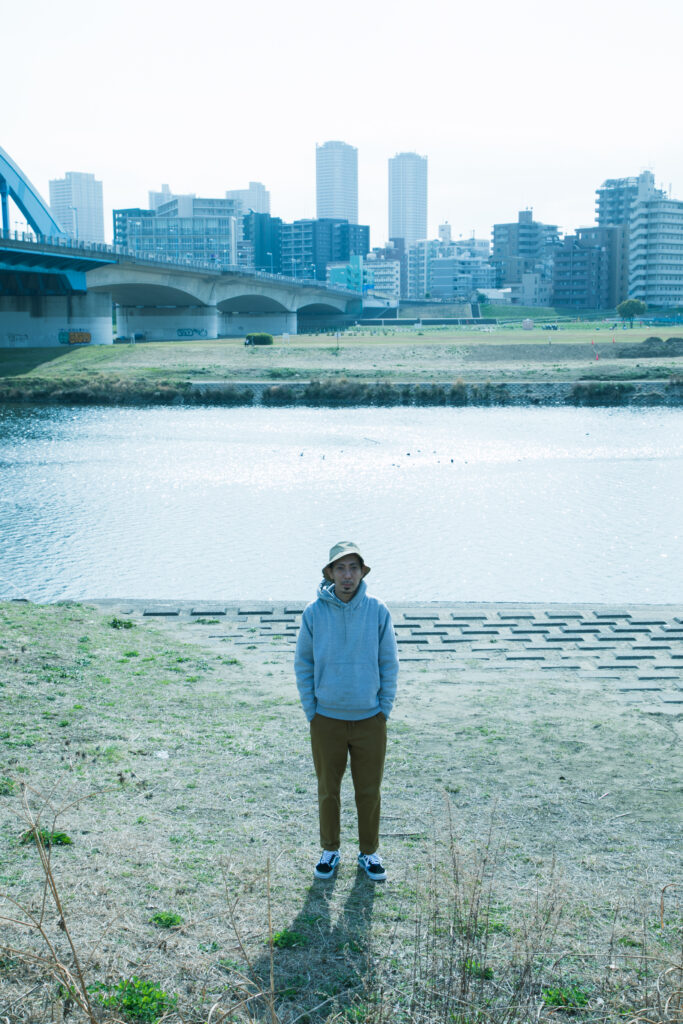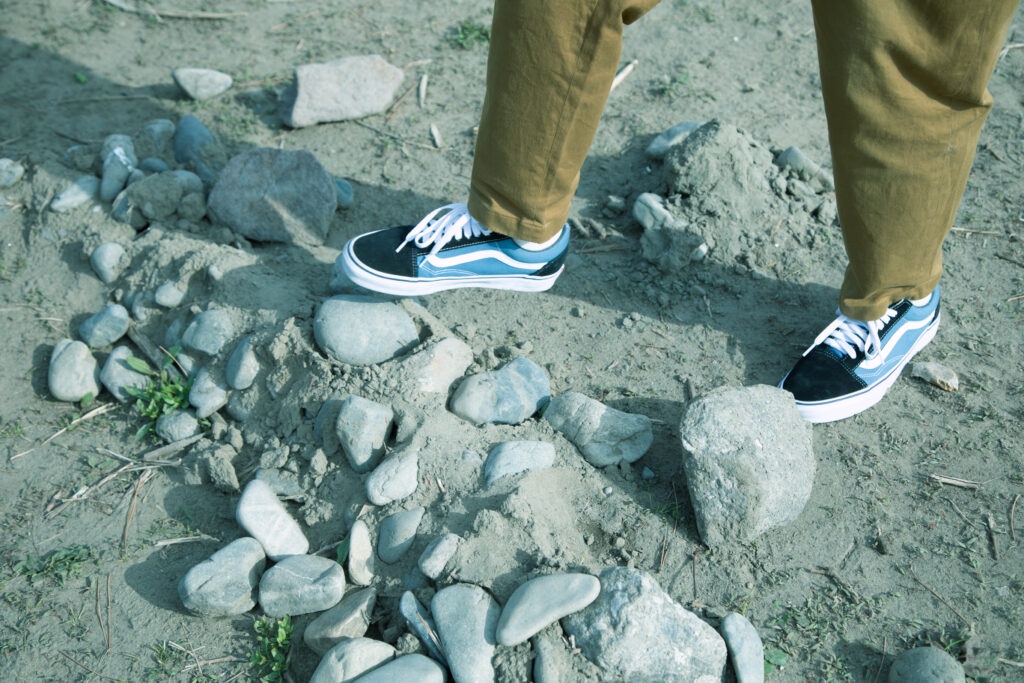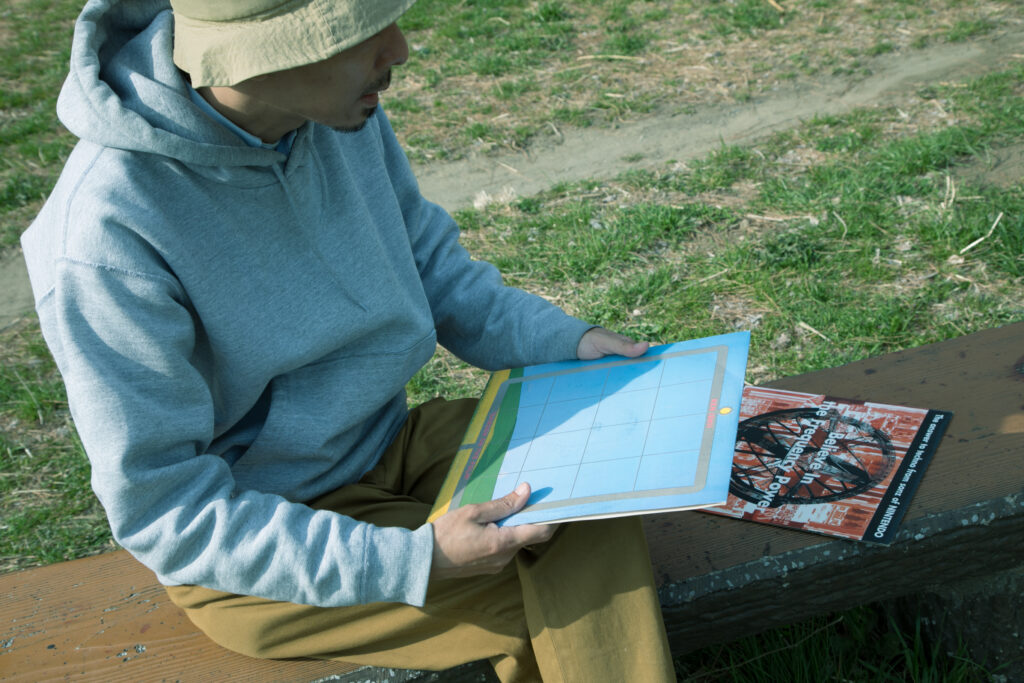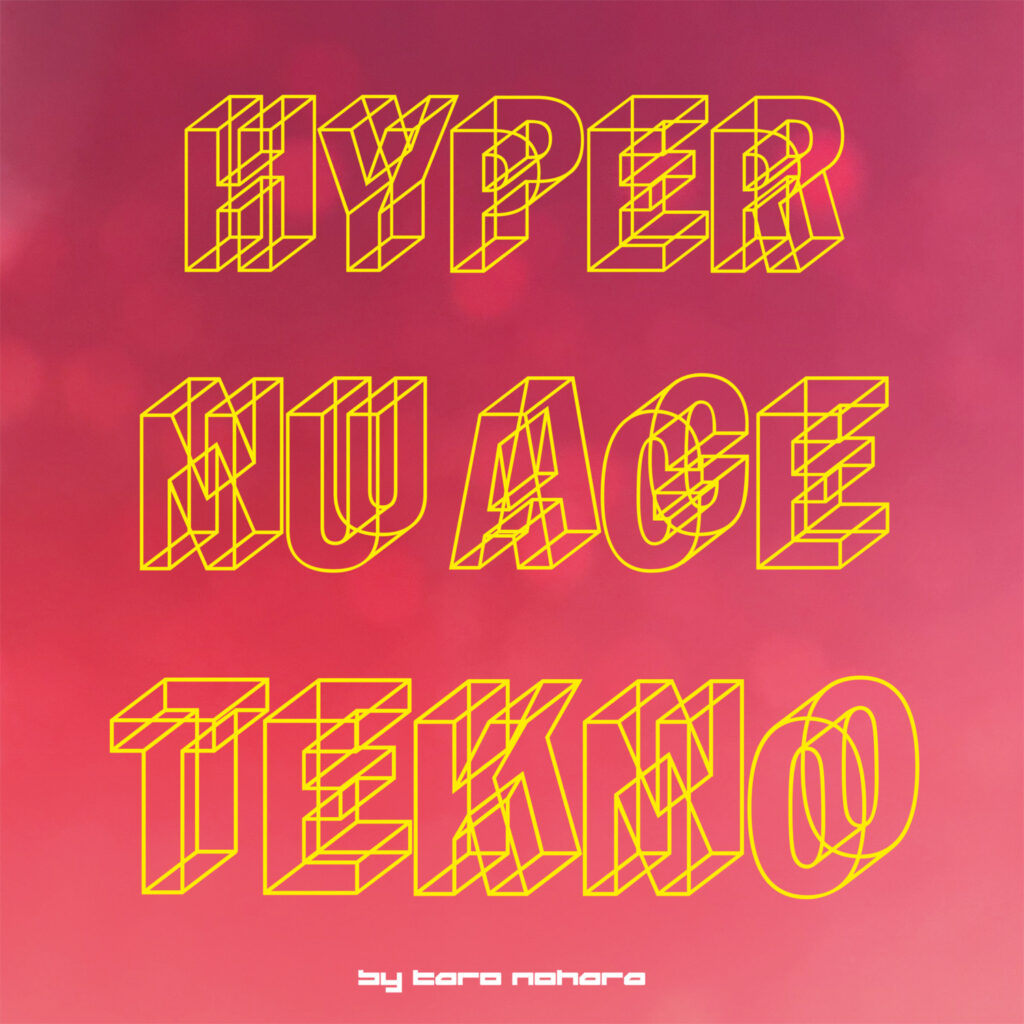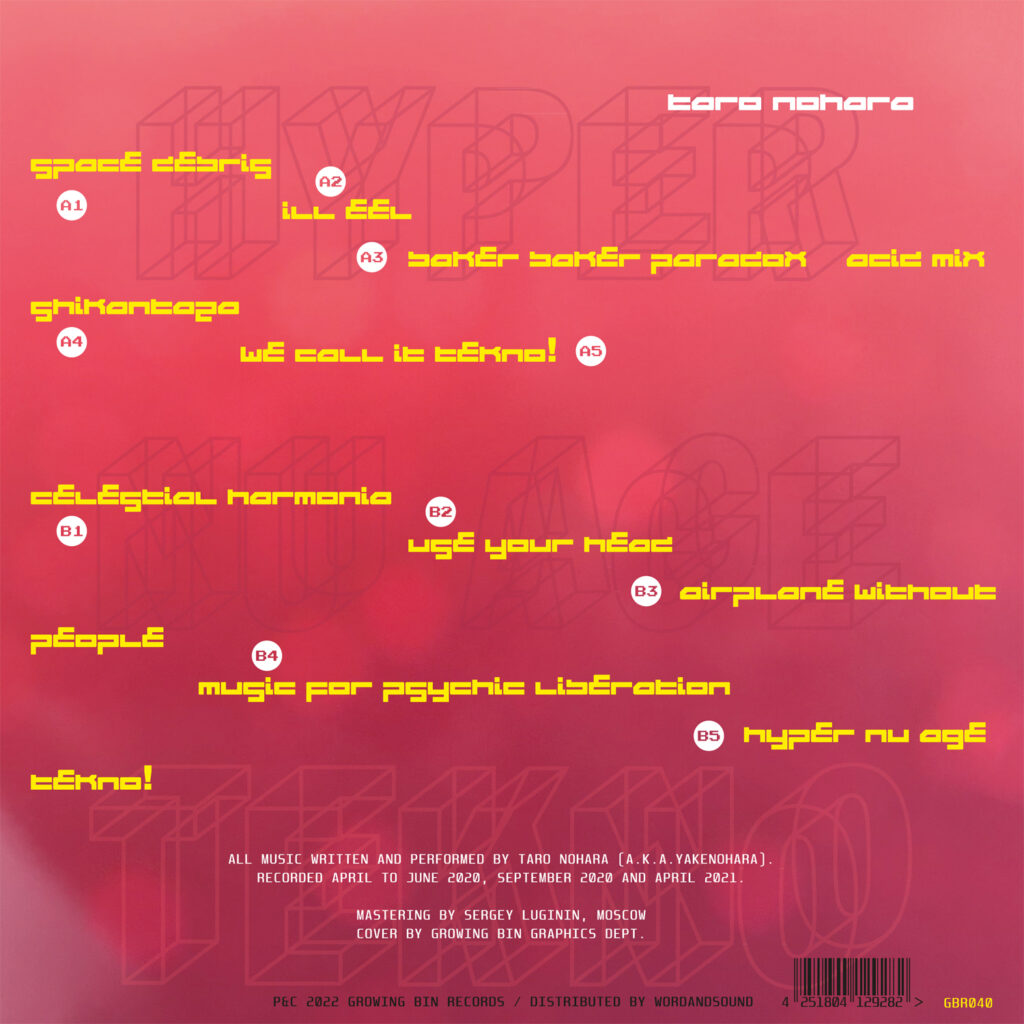DJ/producer/rapper/author Yakenohara wears many hats. Apart from being a member of the popular ambient music unit UNKNOWN ME with P-RUFF, H. TAKAHASHI, and Yudai Osawa, he recently released his record Hyper Nu Age Tekno under the name Taro Nohara with German label Growing Bin. This album attempts to get past the refined musical formats that exist within ambient and techno music history. A middle ground between ambient and 90s techno music, this album provides a spiritual Zen connection between body and mind. I was able to speak to him about completing Hyper Nu Age Tekno.
– Why did you decide to release Hyper Nu Age Tekno on the label Growing Bin, based in Hamburg, Germany? What drew you to the label?
Taro Nohara: I’ve always liked the label Growing Bin, and I’ve bought many of their releases. I decided to go with them because I just so happened to send them a demo. That’s it (laughs). The DJ Basso is the supervisor of Growing Bin, who is a reliable pillar of support. But I was drawn to the parts of the label that didn’t fit within the stereotype. I liked that it valued its uniqueness.
– You released this under the name Taro Nohara. What’s the difference between this name and Yakenohara?
Taro: Basically nothing. If I had to say, the releases under Taro Nohara are probably much more personal. I don’t think about having to do something out of necessity, like because it’s being released or because it’s a form of expression. I wouldn’t say I was only relying on my initial impulses while working on this, but it did feel like music-making was happening organically, out of fun. It’s been a long time since I’ve felt that way.
– When did you start this project?
Taro: When Covid lockdown started, in April or May of 2020. After that, I took some time to rework things, but I wasn’t really thinking about releasing it as an album at the time. But it felt like normal life was forced on hold, so I thought I should create something. By spring of 2020, I had finished five to six songs but didn’t have plans to do anything with it. I let a couple friends listen to it, and it just sat there for about half a year.
Then one day, that friend told me it would be a waste not to release the songs. Growing Bin’s newest release at the time had some dance influences in it, which I thought was similar to what I had made. So I decided to give it a shot and sent them a demo. They ended up liking it and went on to release it.
A project inspired by the purity of 90s techno
– You mentioned earlier that you were drawn to how unorthodox DJ Basso is.Do you think Hyper Nu Age Tekno is a record that tries to stray from stereotypes?
Taro: This album was partially inspired by 90s techno, a genre that I’ve always been fond of.When I first started listening to techno, I felt like there were many different styles within the umbrella of techno music. There’s techno that’s directly connected to dance, there’s IDM or pure techno that’s related to electronica, and many other forms. Instead of playing a specific style that’s considered cool all at once, there’s a lot of variety within the genre. There are also many ways to release a techno record. For example, there are releases that have no album cover, only a record sleeve with a stamp on it. Sometimes, you have no idea where the artist is from or how old they are. The anonymity of it was also cool to me. The individual imagination born out of someone’s bedroom becomes ubiquitous and ends up connecting people. We call that bedroom techno. Being in lockdown during Covid reminded me of a disconnectedness that was reminiscent of bedroom techno. I had that in the back of my mind while working on this project.
– You talked about techno artists being anonymous. I feel like that ambiguity of not knowing where one’s influence is coming from is present in Hyper Nu Age Tekno as well.
Taro: I guess you’re right. Even if you think someone might like techno, you can’t immediately tell what their direct influences are. There are no musical tropes in this album; I might’ve been aiming for that.
– The album cover also looks like a flyer for a 90s techno event.
Taro: Yes. I told DJ Basso that the theme of the album was 90s techno, and he made the cover art. I usually have more detailed ideas, but with the language barrier and everything, I gave him a more general image. It feels like it’s someone else’s record. I feel a distance from it, as if I’m staring at someone else’s album art. I rather like that odd distance, though.
The attraction of polyrhythms
– I’d like to ask a couple questions about the compositions. The first song on side A, “Space Debris”, and the first song on side B, “Celestial Harmonia”, starts off with a powerful kick. I felt like there was a rhythmic desire there.
Taro: Last year, I released the album BISHINTAI with the ambient music group UNKNOWN ME. The four to five years leading up to that, I was really into ambient music. I was interested to know if I could create freeing, versatile rhythms within that ambient mode, something that could only be born out of a rhythm-less environment. Lockdown had first begun when I started making Hyper Nu Age Tekno!. There were less opportunities to meet people and more opportunities to work remotely, and I think ambient music gained popularity for being music you could listen to quietly at home. But as someone who had already been listening to ambient music, I felt the need to do the opposite. I had a hunger for energetic rhythms and for the social aspect that rhythmic music provided. I probably wanted to connect with people and the outside world.
– The second track on side A, “Ill Eel”, felt like an ambient version of a more uplifting music like Singeli.
Taro: I dug through 90s techno because I thought it was interesting, from the perspective of a listener and of a DJ. But I also listen to new music, so you can definitely hear influences from Singeli and newer UK bass techno. With rock, reggae, or with the 90s techno that influenced this record, I’m not interested in doing things that have already been done in the past. So there’s a 90s techno influence with a touch of current bass-like sounds as well. That being said, there are also some elements that were created organically, while playing around.
– Your use of polyrhythms (a rhythm which makes use of two or more different rhythms simultaneously) throughout the record made a lasting impression. It feels like polyrhythm is a keyword in this project.
Taro: Yes, but it’s not really a theme. It’s more like an extension of ambient music that was organically produced. When I thought about how I could create something interesting that’s never been heard before, I thought of including polyrhythms, something I’ve been incorporating a lot in my music recently. But I’ve been using it carefully. I could make it more complex, but I try to strike a balance so it seems normal at first glance, but then you realize it’s actually not in 4/4.
– What is the charm of polyrhythms?
Taro: That’s tough, because there are different charms depending on the perspective. It’s present in a lot of pop music now, but when I first got into polyrhythms, I couldn’t listen to music that didn’t include them. It made me feel sick. I was addicted to polyrhythms. Most music around the world revolves around even numbers like 4 and 8. Being a dance music DJ, I understand the satisfaction that that prolonged form can bring, which is exactly why I felt the need for other things. Polyrhythms have different beat patterns and are constantly shifting. For instance, the fourth, eighth, and sixteenth bars may not align. Instead of repeating fours, it was fun and satisfying to listen to different sets of rhythms move on their own over time. In my mind, the Buddhist/Eastern philosophy of “a river never stops flowing, but the water that runs is not the same” was omnipresent while making ambient music, and I feel like polyrhythms share that commonality. It’s everchanging.
– Is the feeling similar to being zen, since there’s also a track called “Shikantaza”?
Taro: Yes. I felt it was similar to ambient music because it loops forever on its own while simultaneously changing forms. I was drawn to the permanence of its natural form, untouched by humans. This is also a commonality I find with Eastern philosophy. I programmed this project so the synths and timbres would never repeat. For example, in a five-minute song, the five minutes prior doesn’t usually exist. But in my method of music-making, the five-minutes of said song exists because of the five minutes before and the five minutes after. It just so happens that those five minutes were cut out to make that track. Even though you’re the one programming everything, there are still things that surprise you when you create like this. I don’t leave it all up to nature, though. I’ve thought through the balance of what to control and what not to control.
Not including musical phrases that sound human-controlled
– You’re saying this music was created by chance?
Taro: Not all of it. I’d say it’s music that calls upon randomness. In that way, maybe it’s not all random. It’s like creating a system that creates randomness, or that creates endless change.
– Do you feel a sensation of something happening but not?
Taro: Yes, something like that. If you’re playing in a band, for example, there might be a drum fill that signals the musicians to go into the B section, and you might expect there to be a cymbal hit at the beginning of the measure. But in digital music, there’s no need for those signals. This project has some cymbals that are reminiscent of the band sound, but not in the places you’d expect. It’s the same with rhythmic patterns. The patterns shift on their own, creating its own unique groove.
– Interesting.
Taro: There are polyrhythmic and ambient elements in this record, but I’ve included techno rhythms, so there should still be a physical presence, too.
– That’s true. You do feel different grooves.
Taro: I didn’t incorporate more African-American grooves or rhythms that are stereotypically considered groovy. But I did include grooves that don’t feel like grooves. The spaces, polyrhythms, and ambience create the grooves in this case. It seeks out grooves from different angles. I tried to pursue grooves from my own perspective that could be brought about from techno.
What I like about techno and something that I keep in mind when I’m creating is to come up with musical phrases that don’t sound like a human is playing it. A guitar riff, for instance, is something that a human is clearly playing. Although you can have synth techno music sound human-controlled, I like to make my music seem like it isn’t. I think one of the beautiful things about techno is that the sounds exist on their own.
– Thank you. Lastly, which albums would this record be next to if it was on your shelf?
Taro: What I thought of off the top of my head, though predictable, is Aphex Twin’s Selected Ambient Works 85-92, the bible of bedroom techno. I don’t own this record now, but the other would be Neu!’s first album, since this project of mine had some German rock influences as well. You can feel the absence of humans in both CAN and Neu!’s music. So on one end would be Aphex Twin’s Selected Ambient Works 85-92, and I’d buy Neu!’s record to put on the other side.
TARO NOHARA (YAKENOHARA)
DJ,Producer,Rapper.He has performed at the big festival or an underground party for over 10 years.He joined remix works etc. for any kind of over 100 works such as famous pop music artists like Tatsuro Yamashita or YUKI,rock bands,dance music.In 2009 “Rollin’ Rollin'” released by “Tabito Nanao×Yakenohara” became a hot topic,in 2010 he released “THIS NIGHT IS STILL YOUNG”,rap album.In 2013 he released 2nd album “SUNNY NEW LIFE”.
He is also active as a member of the ambient unit “UNKNOWN ME”.
The subtropical-themed work “subtropics” released by LA’s long-established indie label Not Not Fun in 2017 was selected as a featured work by FACT Magazine in the UK, and co-starred with Gigi Masin, a key person in ambient revival.
Twitter:@yakenohara_taro
■Hyper Nu Age Tekno
Taro Nohara
A1:Space Debris
A2:Ill Eel
A3:Baker Baker Paradox (Acid Mix)
A4:Shikantaza
A5:We Call it Tekno!
B1:Celestial Harmonia
B2:Use Your Head
B3:Airplane Without People
B4:Music For Psychic Liberation
B5:Hyper Nu Age Tekno!
https://album.link/taronoharahnat
https://taronohara.bandcamp.com/album/hyper-nu-age-tekno
Photography Mayumi Hosokura
Translation Mimiko Goldstein

